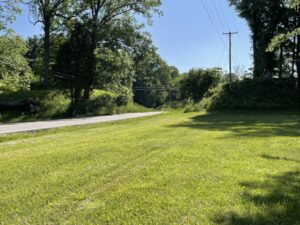HOW?
Ancient people accomplished what seems impossible. How did they do it?
We recently toured the Earthmoving Legacy Center near Elkader, Iowa. On display were diesel and gasoline-powered machines able to move massive quantities of dirt for today’s needs. (Moving Heaven and Earth)
A month later we stood in a field near Chillicothe, Ohio, gazing at an enormous earth mound. The next day we visited other nearby sites with earthen walls, circles, and squares. All were separated by many miles and were large – some spanning hundreds of feet long and dozens of stories high. All were made around 2000 years ago by people of the Hopewell Culture. We learned that the squares are identical and fit inside the large circles. Somehow, they did this hard work without machines. No metal shovels. Not even wheelbarrows. How did they do it?
- Modern intersecting with ancient.
- Headquarters.
Can a Principle of Geology Lend Insights?

Recreated Earthworks
Hopewell, like visits to Effigy Mounds National Monument in Iowa and Cahokia in Illinois, stimulates more questions than answers. Perhaps a tenet of Geology can guide us. The Present is the Key to the Past. So, let’s consider. Why do we build structures? How do we move earth today? What do people who build need to sustain them while they build? (Food, shelter, clothing) Who provides this? Where do we get our goods? Perhaps these questions can provide insight into the past.
History is Written by the “Victors”
In our 1950s and 1960s school classes, we learned that European explorers and early settlers discovered scattered bands of Native Americans making a primitive living hunting, gathering, and gardening. No mention was made of our continent’s once vast population of sophisticated, technologically-advanced, and organized Native Americans who built magnificent structures and had an extensive trade system. Some of us did learn about the impressive Mayan and Aztec cultures in Mesoamerica.
Amazing Commerce

Pipestone was traded far and wide.
Little did we learn about the varied North American indigenous cultures that were far superior than originally believed. For example, Hopewell people made tools of obsidian that originated at Yellowstone, created jewelry of copper from the upper Great Lakes region, and used shells from the Gulf of Mexico. They somehow got these distantly sourced goods without airplanes, trucks, or Amazon Prime! Somehow goods moved across thousands of miles before horses and even wheels were available.
Sources of Information
Archeologists have solved some riddles about how ancient people did things, but many mysteries remain. Puzzling and fascinating. We have had published a number of pieces on ancients including the desert Southwest, to Pipestone in Minnesota, to Mounds along the Mississippi from Effigy to Cahokia.
Together, let us learn more about the rich heritage that is both before, beneath us, and behind us. A good source of information is The Great Courses offerings by Dr. Edwin Barnhart, Ancient Civilizations of North America, and Dr. Daniel Cobb, Native Peoples of North America.




This is fascinating! Thanks for the article.
thanks, Ellen. We just learned about footprints in White Sands, NM dating back 16K years. This is consistent with the evidence from the Meadowcroft-Rockshelter in PA. I’ll send along the feature on that in an email. guess we like old stuff. thanks for your support. bye for now. M~